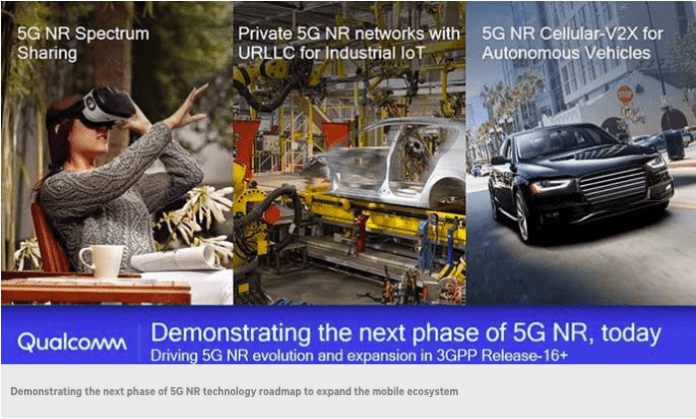 NR — the global 5G standard. This technology roadmap will expand the reach of 5G NR to new
NR — the global 5G standard. This technology roadmap will expand the reach of 5G NR to new
industries, new deployment and business models, and new ecosystem participants. The expansion of the mobile ecosystem is starting today with LTE solutions and will now continue with 5G NR, building on a solid foundation established by the recently completed 5G NR Release-15 standard.
The first 5G standard was largely driven by Qualcomm, which was exemplified by our successful completion of the world’s first 5G NR interoperability testing with ZTE (for mid-band spectrum) and Ericsson (for mmWave spectrum) in late 2017. We built upon this leadership last week with our announcement of successfully completing 5G NR interoperability testing with Nokia. This standard-compliant interoperability testing was done in collaboration with 20+ global operators on the path to over-the-air field trials staring in 2018 and commercial network launches for enhanced mobile broadband staring in 2019 — powered by the Qualcomm Snapdragon X50 5G NR modem.
As the R&D engine fueling the 5G industry, we have already started to work on the next wave of 5G NR technologies that will pave the way to the subsequent 5G NR standard releases in 3GPP Release 16 and beyond. Building on the solid Release 15 foundation, we expect the next phase of 5G NR to shift much of its focus to use cases beyond enhanced mobile broadband (eMBB). To this end, multiple technology studies have already begun in the 3GPP standardization efforts. To help drive this 5G NR technology roadmap in 3GPP Release 16 and beyond, today we announced our plans to demonstrate three of these focus 5G NR expansion areas at Mobile World Congress 2018 in Barcelona later this month. I’m excited to share more with you on these three focus areas.

Demonstrating the next phase of 5G NR technology roadmap to expand the mobile ecosystem
5G NR Spectrum Sharing — bringing opportunity for a revolutionary path and significant benefits
Ensuring that all spectrum types are supported by 5G NR is crucial to the broad and rapid proliferation of 5G, as spectrum is the lifeblood for wireless communication. Building on the LTE foundation, 5G NR will also operate in unlicensed spectrum, including licensed and unlicensed spectrum aggregation (5G NR version of LAA) as well as standalone operation in unlicensed spectrum (5G NR version of MulteFire). The approved Study Item also provides a great opportunity to introduce revolutionary 5G NR spectrum sharing paradigms that can deliver significant benefits, both in terms of increased spectral efficiencies, higher perceived user data speeds, horizontal and vertical sharing, and guaranteed QoS. This new way of sharing holds the promise of enabling more operators to offer fiber-like 5G experiences with limited shared spectrum assets. We will be showcasing advanced spatial spectrum sharing techniques with Spatial Domain Multiplexing (SDM) and Coordinated Multi-Point (CoMP) in our booth at Mobile World Congress in Barcelona later this month.

5G NR Spectrum Sharing demonstration
Private 5G NR network — enabling advanced Industrial IoT use cases
Another focus area of ours is the work on private networks — an on-premise, optimized, and dedicated network that can scale to a wide range of use case requirements. Today, we are enabling industrial IoT applications with private LTE networks, but tomorrow’s private 5G NR networks will bring new capabilities and efficiencies. 5G NR URLLC, which is being designed to deliver sub-millisecond latency and ultra-high reliability, can enable precise command-and-control for high-demand factory automation applications. For example, the ability to run industrial ethernet wirelessly will enable dynamic reconfigurable factories — a key concept of Industry 4.0 — to increase productivity and flexibility. At MWC 2018, we will showcase an industry-first demonstration of a PROFINET Industrial Ethernet over 5G NR.

Private 5G NR IoT demonstration
5G NR based Cellular-V2X — targeting new use cases for autonomous driving
C-V2X is an important technology for enhanced road safety and plays a role in the future of autonomous driving. There is a strong C-V2X momentum building with a broad ecosystem support due to its robust performance, cost effectiveness, and 5G NR forward compatibility. In 2017, we saw the completion of the first C-V2X specification as a part of 3GPP Release 14, the start of multiple trials, and the announcement of our first C-V2X solution — the Qualcomm 9150 C-V2X chipset. And we continue to push forward with backward compatible improvements to C-V2X technologies. As I outlined in my webinar last week, Release 16 5G NR will bring high throughput, ultra-reliable low latency communication (URLLC) capability into the system and enable advanced use cases for autonomous vehicles. These include high throughput sensor sharing, intent sharing, and 3D HD map updates. At MWC 2018, we will showcase the potential role of 5G NR based C-V2X in autonomous driving, wherein the technology will allow vehicles to share their intent for higher level of predictability. Such radio techniques complement cameras and sensors used for advanced path planning.

5G NR C-V2X demonstration
5G technology demonstrations at Mobile World Congress 2018 in Barcelona
In the same way that our early R&D work on 5G led to the accelerated completion of the first 5G NR standard for enhanced mobile broadband, these demonstrations highlight our continued commitment to inventing technologies that drive the mobile ecosystem forward.
We’re excited to demonstrate these advancements at Mobile World Congress and showcase how they will expand the reach of 5G NR to new industries, new deployment and business models, and new ecosystem participants. If you plan on attending the show, be sure to stop by our booth located in Hall 3, Stand 3E10.
Missing MWC this year? Visit our 5G @ MWC18 virtual showroom to see the full demos when the show starts Feb 26th.

